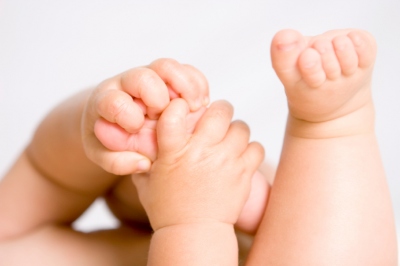Discovery Reshapes Understanding of Embryonic Development
UC San Francisco Study Examines How Cells Communicate to Form Fingers and Toes

When a baby is born, one of the first things a parent will do is count fingers and toes. New research conducted at UC San Francisco sheds lights on how these specialized digits are formed.
In a finding likely to fundamentally reshape biologists' understanding of how cells communicate to each other during development, researchers have found a new way a known cellular structure passes along instructions critical to the formation of the limbs and digits of developing embryos.
As a national leader in neonatology, UCSF’s mission is to initiate and rigorously pursue both basic science and clinical research to better treat, and one day eliminate, neonatal diseases. UCSF Benioff Children’s Hospital is one of the top ranked children’s hospitals in the country, and is committed to training physician-scientists to investigate human development and the root causes of congenital anomalies.
“The findings are a significant advance in developmental biology that will help to understand the basis of certain birth defects that alter the number or specification of fingers and toes,” said David Rowitch, MD, PhD, chief of neonatology at the children's hospital.
The research was published online April 28 in Nature.
The researchers focused on the molecule called “Sonic hedgehog” (SHH), which acts to pattern precursor cells that make the specialized digits in a developing chick embryo. Equipped with custom-made, high-powered microscopes to visualize the cells and an approach that avoided damaging tissue preparation, the researchers got an unprecedented look at previously invisible extensions of cells that form tube-like projections.
"The presence of these structures, which we call filopodia, was really unexpected," said senior author Maria Barna, PhD, who conducted the research at UCSF and is now an assistant professor of developmental biology and of genetics at Stanford University.
The Role of Filopodia
Specialized filopodia, called cytonemes, were previously shown by UCSF investigator Tom Kornberg, PhD, of the UCSF Cardiovascular Research Institute, to mediate cell-cell signaling in the fruit fly Drosophila. This earlier research also observed similar structures in chick embryos, work that has now been extended by Barna and her colleagues.
The researchers got an unprecedented look at previously invisible extensions of cells that form tube-like projections. These specialized filopodia pass along critical instructions essential for the formation of the limbs and digits of developing embryos.
The researchers found that the newly identified, nearly invisible finger-like projections burrow through tightly packed tissue in developing chick and mouse embryos for several cell-lengths. Once contact between cells through these structures has been made, signaling molecules can be delivered directly from one cell to another.
The researchers believe that cells use specialized filopodia as a means of targeted delivery of key signaling molecules in the limb to instruct formation of, say, a thumb versus a pinky finger. If that communication mechanism breaks down, then malformations occur – such as too many or too few fingers or toes.
The wider implication for this research is that similar mechanisms might underlie developmental pattern formation in other organs such as the brain. If so, scientists can learn how and why congenital anomalies occur in other parts of the body.
Lead author Timothy Sanders, MD, PhD, now of Children’s Hospital of Pittsburgh, was a fellow and faculty member in the Division of Neonatology in the Department of Pediatrics at UCSF Benioff Children’s Hospital while conducting the research. He was supported by a National Institute of Child Health and Development training program award (grant T32HD071860), which was critical for the report of these studies. Esther Llagostera, a UCSF post doctoral fellow, is co-author.
The research was supported by the Spanish Ministry of Education and Science, the Program for Breakthrough Biomedical Research at UCSF, the March of Dimes Basil O'Connor Scholar Research Award and the National Institute of Arthritis and Musculoskeletal and Skin Disease (grant R21AR062262).